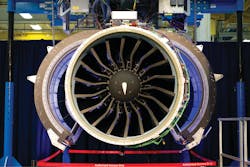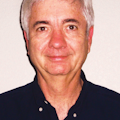Turbine Technology: Innovations in Turbine Engines
A common definition of innovation “is the creation of better or more effective products, processes, services, technologies, or ideas that are accepted by markets, governments, and society.” An innovator can be an organization that is first to introduce something better than what exists, which often opens up a new area for others to build on.
Examples of innovative aircraft engines are the R1340 Wasp, the JT-3, the PT-6, and the JT-9. Pratt & Whitney would be considered an innovator of aircraft engine technologies. After 20 plus years of research and development the PurePower PW1000G geared turbofan engine family is operational. It appears that the PW1000G engine is new from the spinner to the tail cone.
According to experts, this engine is a model of innovation and not another of P&W’s traditional turbofan engines with a few incremental improvements. AMTs always want to get their hands on a new engine, to look under the cowling and learn more about mounting, servicing, maintenance and overhaul. The PW1000G is a new engine that has not yet seen continuous airline service.
Innovative design
The fan drive gear system (FDGS) is the fulcrum of the innovative design for the PW1000G. P&W took years and spent about a “billion dollars in research and development” to prefect this geared system. The robust “star gear system leverages the basic laws of physics to improve propulsive efficiency.” The reliable gearbox is, lightweight, about “20 inches in diameter and transmits about 30,000 horsepower.” The FDGS follows the fan shaft but separates the engine fan from the low pressure compressor and turbine. The “fan rotates at a slower speed and the low pressure compressor and turbine operates at a higher speed. This allows each engine module to operate for optimum efficiency.”
This engine has significant improvements in aerodynamics, application of lightweight materials and efficiency gains with the high-pressure spool, low-pressure turbine, the combustor, engine controls, and the engine health and maintenance monitoring systems. These improvements are made possible by the step change in the basic engine architecture of the fan drive reduction gear. The engine has a lightweight composite fan case and low-pressure fan that move more than 90 percent of inlet air around the core engine.
This design resulted in a “50 to 75 percent reduction in engine noise over current models, a remarkable 12:1 bypass ratio, and an expected 16 to 20 percent better fuel burn over today’s engines.” The compact, high-speed low-pressure system runs cooler and accomplishes more work with fewer stages, a design feature that helps reduce the number of airfoils and life-limited parts. “The high bypass ratio and the efficient Talon X combustor help reduce fuel burn and carbon and nitrogen oxide emissions.”
Maintenance and overhaul
From the information published about the PW1000G, it appears the P&W engineers have been very considerate of the maintenance community. The interviews suggest that the engine has many features that facilitate maintenance and reduce time and cost while the engine is in overhaul. P&W also offers a “PureSolution Service” maintenance plan customized to the scope and scale of the owners’ operation.
The health of the PW1000G engine is monitored by a P&W maintenance team, 24x7 regardless of location. They do this by using “enhanced diagnostics that will enable a considerable increase in the level of data with improved speed and reduced operating costs for the airline.” Once the data is in and analyzed, the P&W support team provides the best solutions to address on and off-wing trouble shooting and engine repair or exchange.
Bob Saia, vice president of the Next Generation Product Family, provides an additional level of detail. According to Saia, the PW1000G has the “latest generation FADEC” engine control and typical cockpit controls and operating displays. The engines are “top mounted with a high level of integration between the engine, the nacelle system, and the aircraft. This resulted in fewer parts and easier maintenance. The nacelle system is designed for quick access during line maintenance activity. The bypass ducts and cowl also have separate side openings to minimize overall line maintenance time. The oil filter is mounted on the engine core and the location of the oil servicing port is to be determined by the airframe OEM.” Saia indicates that “there are no special service requirements for the engine and P&W has incorporated advanced diagnostics and health monitoring features in the electronic control which will eliminate several of the traditional engine servicing tasks. The FDGS design had been proven and has demonstrated a high level of reliability.”
There are no special maintenance requirements for the FDGS. It has only seven moving parts which are not life-limited. How’s that for simplicity. It is “lubricated with engine oil, has no special vibration monitoring requirements, and has a standard compartment chip detector. The inspection requirements for the FDGS are similar to those the accessory gearbox gets during a major engine overhaul shop visit.” The accessory gearbox had a complete makeover, a simpler design, containing fewer parts, and a cleaner look. The gearbox is core mounted, its components are modular, share functions, and are located close to the modules they control. The core engine mount reduces the number of wire bundles, tubes, and connectors which facilitates accessibility and reduces the overall maintenance effort.
“This engine does not require any special equipment to transport, mount, overhaul, or test. It is a highly efficient 17 stage modular engine. The modules are: fan, fan case, a three-stage LPC, intermediate case, an eight-stage HPC, diffuser and combustor, a two stage HPT, mid turbine frame, a three-stage LPT, and TEC. The reduced number of stages means a huge reduction in the number of blades and vanes. The engine is initially disassembled horizontally then depending on the bill of work can be worked horizontal or vertical. There are eight major assembly flanges that facilitate more efficient bills of work and reduce time spent in overhaul. Maintenance and shop manuals will be available online, on CD-ROM or in hardcopy depending on the customer’s need.”
Customer acceptance and recognition
It appears that aircraft operators have readily accepted the innovations that the PW1000G represents. Currently “there are more than 2,000 PurePower engines on order, including options, by customers around the world.” The engine has been selected for the Mitsubishi Regional Jet (MRJ), the Bombardier C-Series, and Irkut MC-21 aircraft. Airbus announced it will offer the PW1100G-JM engine as an option for the A320 neo family of aircraft. Once these engines are in operation the owners and operators must maintain these engines to OEM specifications.
The PW1000G engine was recognized by Popular Science Magazine with a 2009 “Best of What’s New Award,” a “2009 Aviation Week Laureate Award for outstanding achievement in Aeronautics and Propulsion,” and the “2008 Technology Breakthrough Award from the China Aviation Association and AVIC Science and Technology department.” In November, TIME Magazine named the PW1000G engine as one of “The 50 Best Inventions of 2011”, describing it as "the most important development in aviation in 2011.”
The PW1000G was also one of the six green inventions honored because test data suggests that it “can cut carbon emissions by more than 3,000 metric tons and NOx exhaust gases 50 percent below CAEP/6 (Committee on Aviation Environmental Protection).” P&W states that the “PW1000G can achieve a 50 to 75 percent reduction in operating noise.” After years of living a stone’s throw from DFW’s west runways, I feel that many local residents will rejoice when they hear the news about noise reduction. For other airports and operators this translates to “efficient aircraft flight paths, extended curfew operation, and quieter crew and passenger cabins.” For operators and AMTs this means fewer restrictions on test cell operations and flight line trim runs, and could equate to a savings of about “$1,000,000 per aircraft per year.”
Benefits of innovation
The innovative PW1000G engine addresses “the whole picture fuel, emissions, noise, and maintenance to give their customers the lowest operating cost with architectural simplicity and low risk.” The improvements in fuel economy, lower emissions, and engine noise are substantial and quite timely considering that the beleaguered aviation industry is coming under increasing scrutiny due to global pollution and subsequent environmental changes. These improvements will provide immediate benefits to the environment, engine and aircraft operators, and the general public. To Pratt & Whitney, the innovator - thanks for a job well done.
For more information visit www.purepowerengine.com.
Charles Chandler is an AMT field editor and A&P based in Michigan. He received his training from Spartan College of Aeronautics.
About the Author
Charles Chandler
Charles Chandler began his aviation career as a junior mechanic for American Airlines and retired after 27 years of service. Charles Chandler has a Master’s of Science degree in adult and occupational education with a major in human resources development.

